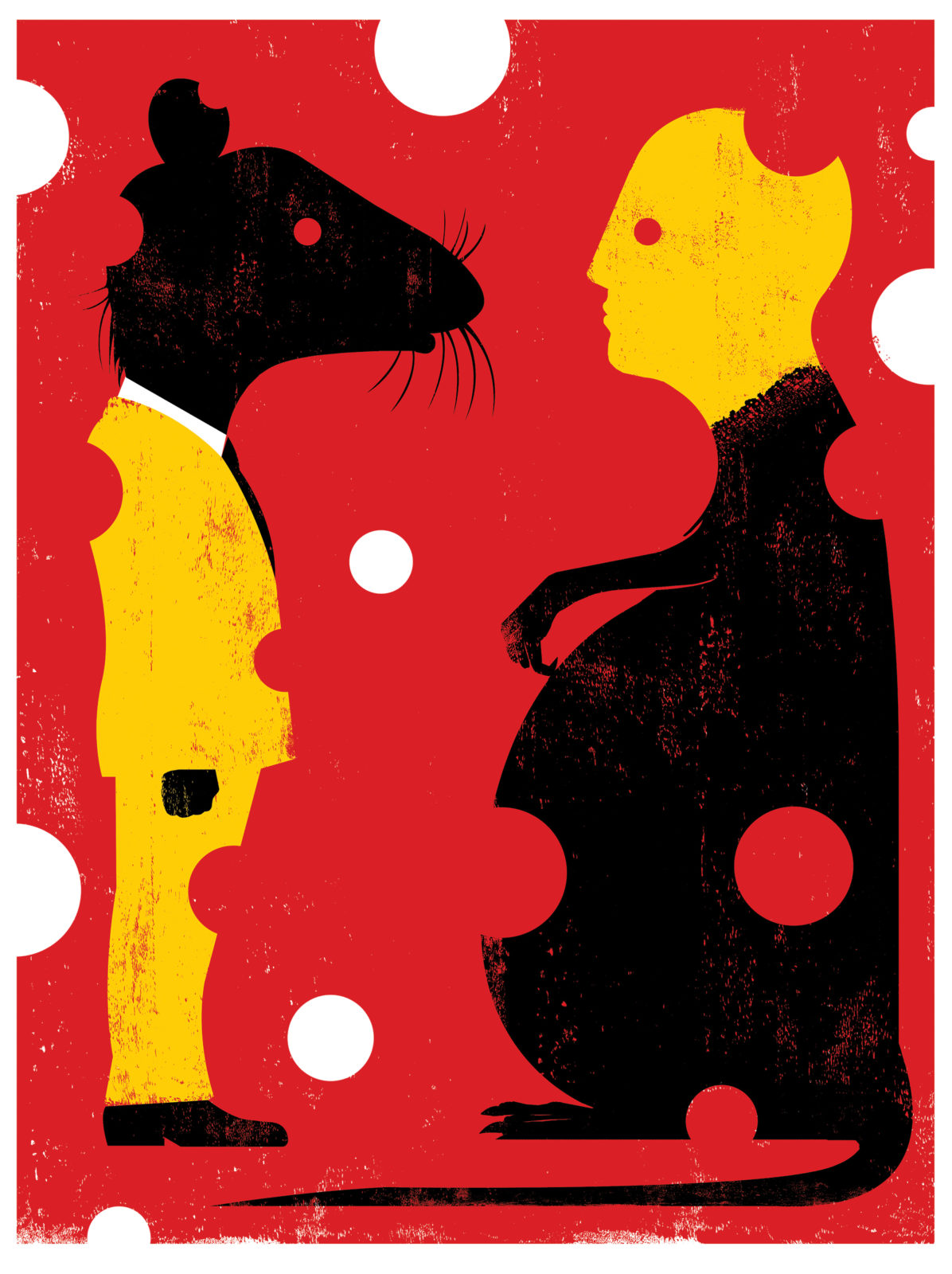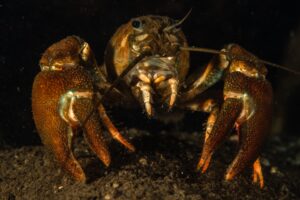
Plague’s story in the U.S. begins 120 years ago, in the basement of the Globe Hotel, a cheap rooming house on Dupont Street in San Francisco’s Chinatown. Wong Chut King, a 41-year-old lumberyard worker who had immigrated from China’s Guangdong Province 16 years before, shared a windowless room beneath the hotel’s sidewalk with three other immigrants. They took turns sleeping in the room’s single bed. Water from an underground cesspool seeped through the walls. An open sewage pipe ran above the room.
At the end of February 1900, King came home with a lump in his groin that quickly became so painful he could not urinate or move. As his temperature climbed, his tongue turned white and furry and sores sprouted across his lips. For days he was racked with vomiting and diarrhea. When he fell into a coma, his roommates, skeptical about his survival, took him to a nearby coffin shop. King died there March 6.
The lump in his groin was a telltale sign. When city bacteriologist William Kellogg showed up to inspect King’s body, he immediately suspected the plague. The city’s Board of Health quickly cordoned off Chinatown, surrounding it with blockades guarded by police. The San Francisco Chronicle called Kellogg’s diagnosis a “bubonic bluff”—plague had never occurred in the U.S. But Kellogg knew that the ancient disease had recently cropped up in ports across the Pacific. Only months before, it had caused such a severe epidemic in Honolulu that desperate health officials there had burned down patients’ homes to stop its spread.
Chinatown residents feared the same would happen in San Francisco, especially as the police allowed whites to cross the cordon while they prevented Chinese residents from leaving. Chinatown was home to 30,000 people confined to a 12-block radius by racist redlining practices that denied Chinese immigrants access to other parts of the city. In its crowded, brick-and-wood tenements, rooms for one or two housed eight, running water was scarce, and indoor plumbing was either nonexistent or “grossly inadequate,” says Susan Craddock, a professor of gender, women’s, and sexuality studies at University of Minnesota and author of City of Plagues. A group of prominent Chinatown business leaders, convinced the quarantine was a pretext for discrimination, hired lawyers and threatened to sue the city. When no new plague cases appeared after three days, the city relented and the cordon came down.
But the act proved hasty. Dead rats began to appear in Chinatown’s courtyards and alleyways. And then word came back from a quarantine officer of the federal Marine Hospital Service, Joseph Kinyoun, who had tested samples from King in his lab on Angel Island. Kinyoun confirmed Kellogg’s diagnosis: King had in fact died of plague. And as March turned to April, several more Chinatown residents succumbed to the disease.
Chinatown leaders denied the reports of plague—and, fearful of an epidemic’s economic repercussions, so did others in power. Mayor James D. Phelan sent telegrams to the mayors of dozens of other cities, assuring them that San Francisco had seen just a single, isolated case—nothing more. Governor Henry Gage told reporters that Kinyoun had caused San Francisco’s cases himself, by letting the plague germ escape his lab. Gage even proposed making it a felony for newspapers to publish “false” reports on the presence of plague in the state.
They all had good reason for the denials. Kinyoun was urging for a naval quarantine to keep ships from entering or leaving the city’s ports, as well as mandatory health passes for any San Franciscans who wanted to leave the city by sea or land. Neighboring states threatened to block travelers and goods coming out of California. Admitting to plague would devastate tourism and trade, wrote Marilyn Chase in Barbary Plague: The Black Death in Victorian San Francisco. “No one wanted to see the yellow flag of pestilence flying over the portal to the Golden Gate.”
An Ancient Disease
Plague’s centuries-old reputation preceded its arrival in the City by the Bay. In the sixth century, the Plague of Justinian ravaged Europe, Asia, and Africa, claiming nearly a hundred million lives before it burned itself out. A second pandemic began in the fourteenth century, originating in Asia and spreading along trade routes to Europe, where it quickly killed a quarter of the population and became known as the Black Death. In the 1850s, a third pandemic began with a series of small outbreaks in southern China. By the 1890s, those outbreaks had spread to commercial coastal cities, killing over 2,500 people in Hong Kong and 35,000 people in Canton. All the while, ships arrived and departed from those cities’ ports, taking the disease with them.
In 1899, one such ship docked in Honolulu, triggering an outbreak there. In the midst of one outbreak, the steamship Australia stopped at the Honolulu port before departing for San Francisco. When the SS Australia arrived in San Francisco, it delivered rats along with its passengers and cargo, and the rats scurried into sewer pipes that ran from the city’s port a mile up to Chinatown.
“At that time, ships had a lot of rats on them, and it’s not really too surprising at all that plague was in some of those rats,” says Dean E. Biggins, a U.S. Geological Survey wildlife biologist who studies plague’s ecology.
Brown rats (Rattus norvegicus), native to China, are important in spreading the plague, but they don’t act alone. The rodents are one of many mammals that can host the rod-shaped plague bacterium, the Yersinia pestis bacillus, in their bodies. Fleas transmit the bacillus from rodents to other mammals. When a rat flea, such as Xenopsylla cheopis, bites an infected rat to feed on its blood, the bacillus subsequently multiplies so copiously inside the flea’s digestive system that clumps of bacteria soon block its gut. When the hungry flea tries to feed off of a new host, it regurgitates the bacteria into the bite wound.
Plague experts now know that at least thirty different flea species can transmit plague, and that some of them are better at it than others. The domestic rat flea Nosopsyllus fasciatus can spread plague, as can the mouse flea Malaraeus telchinum and the ground squirrel flea Oropsylla montana—formerly Ceratophyllus acutus—is now the most important flea vector of plague in the U.S. In San Francisco in 1900, the flea vector that did most of the work, according to medical historian Guenter Risse, author of Plague, Fear, and Politics in San Francisco’s Chinatown, was the rat flea Nosopsyllus fasciatus.
Fleas that take a plague-infested blood meal often die of hunger and dehydration. In rats, the plague bacillus quickly wreaks havoc. The rodents can develop painful and debilitating buboes from the infection, as the bacillus destroys their organs and spreads to their lungs. And then, within a few days, “they just drop dead,” says Paul Mead, chief of the Centers for Disease Control and Prevention’s Bacterial Diseases Branch in Fort Collins, Colorado.
When fleas have infected enough rats that the rat population begins to drop, the fleas seek other warm-blooded hosts to feed on. And when rats live in close quarters with people, as they did in San Francisco’s Chinatown, those people are the most convenient hosts.
Cycles of Plague
Scientists recognize two cycles of plague, an urban cycle, in which flea bites transmit the disease from rats or other rodents to people, and a sylvatic cycle, in which fleas transmit the disease among susceptible hosts in the wild. But when plague arrived in San Francisco in 1900, it was an exclusively urban disease, in part because the cramped quarters of urban poverty created such ideal conditions for its spread.
In people, the plague manifested in two forms: bubonic, in which bites from infected fleas cause the lymph nodes to swell into painful buboes, like the one in King’s groin, and pneumonic, which develops when the infection spreads to the lungs or when a healthy person inhales the exhalations of the sick. (A third form, septicemic plague, develops when the bacillus multiplies in the bloodstream.)
For the next three years, plague continued its spread through the city, from person to person, and from rat to flea to person. It moved quickly at first, then sporadically. Under the direction of Kinyoun, and then his successor Rupert Blue, an assistant surgeon with the Marine Hospital Service, the city’s health department washed and fumigated thousands of residences to eliminate fleas. They tore down dilapidated balconies, platforms, and decks harboring rats in their nooks and crannies. By the time the extermination campaign was complete, San Francisco had suffered 121 cases, 113 of them fatal.
That 93 percent mortality rate signaled plague’s primarily pneumonic spread. “Plague is at its most lethal when it is transmitted from lungs to lungs,” wrote Risse. The small number of cases, meanwhile, was due to the inefficiency of the local flea vector, its breeding compromised by a concurrent relative drought, as well as pneumonic plague’s gruesome symptoms, which included violent and bloody coughing at its most contagious stage. Plague in that form, said Mead, “produces a lot of fear and a lot of social distancing without any sort of encouragement.”
Mayor Phelan was among the fearful; he never admitted to the disease’s presence in his city. But in 1903 his successor, Eugene Schmitz, along with the new governor, physician George Pardee, signed a declaration of plague’s existence in the state.
Mayor Phelan was among the fearful; he never admitted to the disease’s presence in his city.
That same year, Blue received word of a patient at San Francisco’s German Hospital. A blacksmith from Pacheco, a former port town near Suisun Bay, was in dire condition; his buboes indicated plague. Plague wasn’t known to exist outside the city, so Blue crossed the Bay to investigate.
He learned that the blacksmith had never traveled to San Francisco, or even Oakland. But days before he fell ill, he shot and collected several California ground squirrels (Otospermophilus beecheyi). The next month, San Francisco’s Southern Pacific Hospital admitted a man in similar condition, from San Ramon; he, too, had the plague. Blue learned that the man had been working in a railroad camp where the laborers often killed and dressed ground squirrels for food.
Blue dispatched a physician to travel across Alameda and Contra Costa counties inquiring about ground squirrels. The ranchers and farmers there reported that occasionally the rodents went missing from places where they had once been common. People didn’t mind: on managed land, the burrowing rodents were considered pests. One rancher even said he had heard of other ranchers tracking down sick and dead ground squirrels and bringing them back to their own land, hoping to spread whatever the animals had.
Blue sent a team of men to collect rodents in Contra Costa County for testing. Few of the more than 500 animals they caught were infected with plague. But Blue’s successor, William Wherry, was skeptical of the finding. He spent the next few years documenting evidence of plague in East Bay ground squirrels himself.
Wherry then pieced together what he knew: human (aka house) fleas, Pulex irritans, were found on brown rats on both sides of the Bay. The squirrel fleas Ceratophyllus acutus (now known as Oropsylla montana) and Hoplopsyllus anomalus bit rats and could also bite humans. Ranchers described watching rats leave the cities during fall to feed on the harvest and then move into the network of holes, tunnels, and underground chambers the ground squirrels had made on their land. It was not hard to see how the squirrels had picked up the disease. More troubling, he thought, was what this meant for the state.
“It seems altogether likely,” Wherry wrote, “that ground squirrels may act as a host for the Bacillus pestis in the interim between more noticeable outbreaks in rats and men.”
Earthquakes and Fire
Three years later, much of San Francisco was leveled by the 1906 earthquake and fires that followed, disasters that created optimal conditions for plague’s return. Hundreds of thousands of San Franciscans found themselves living in tent encampments throughout the city, where, says Craddock, “there was nothing to protect them from having contact with rats.”
A year after the quake, a man who had been living aboard a tugboat was the first to be diagnosed. That summer, more cases turned up. The disease then coursed, in bubonic form, through nearly every neighborhood. This time, city health officials aimed “to build the disease out of existence,” says Craddock. They replaced the city’s wooden wharfs, docks, and sidewalks with cement ones. They tore wooden decks and porches off people’s homes. And they rebuilt the city’s sewers, making them larger, more structurally sound, and less hospitable to rats.
The city also paid residents to bring in rats for examination, ten cents a head. Health Department technicians autopsied them all until they were convinced they had found the last one with Yersinia pestis in its body. By November of 1908, the epidemic in the city was over. One hundred and sixty people had contracted the plague; roughly half of them died.
“It was the last major epidemic in San Francisco,” Craddock says. “There were cases that came later, but they were minor, and it never became an epidemic.”
Nonetheless, Wherry’s prediction proved true. A period of urban, coastal plague outbreaks followed, hitting Seattle, Oakland, New Orleans, several port cities in Texas and Florida, and then Los Angeles. All told, the urban outbreaks of the early 20th century infected about 500 people and killed half of them. A 1924 outbreak in Los Angeles was the last of them.
But it was also the beginning of a new plague era. What followed was a series of rural outbreaks—only these affected mostly wildlife, and they took far more lives than the disease had ever taken in people.
Epizootic
In 1929, a plague epizootic—an epidemic in animals—decimated the Columbian and Townsend’s ground squirrels and yellow-bellied marmots in northeastern Oregon. A separate epizootic that year struck ground squirrels in Elko County, Nevada. In 1932 plague was killing off ground squirrels including the Columbian, Uinta, and Richardson’s in eastern Idaho and Montana, and a massive epizootic in Arizona “nearly exterminated” the Gunnison’s prairie dog zuniensis subspecies in the state’s northwestern corner, according to painstaking documentation by C.R. Eskey and V.H. Haas, physician-scientists with the U.S. Public Health Service, the federal agency that had by then arisen from Kinyoun’s Marine Hospital Service.
At the request of Surgeon General Thomas Parran, then head of the PHS, Eskey and Haas spent the late 1930s driving across the West in a round-topped laboratory truck outfitted with gloves, aprons, dissection pans, and tray-tables that slid out the back of the vehicle so they could dissect in the field. With the help of state health officers, they collected tens of thousands of fleas and shot, trapped, and dissected a long list of rodents: medium and small ground squirrels (“improperly” known as gophers, they noted), “native” rats and mice, as they called them, and various other rodents in the Sciuridae family, including squirrels, chipmunks, marmots, and prairie dogs.
By 1940, they reported to Parran, the disease was in all 11 Pacific Coast and Rocky Mountain states, in “every type of terrain encountered in the West, from seacoast to mountain, from desert to forest, from valley to plateau.” Since their predecessor William Kellogg had recognized the first human case in the U.S., plague had made its way thousands of miles eastward and into dozens of species, no longer confined to urban rats and peri-urban rodents on the coast.
They found plague from seacoast to mountain, from desert to forest, from valley to plateau in the West.
“A great reservoir of infection has thus become established in the West,” they wrote.
Eskey and Haas noted that nearly all of the rodents affected by plague were colonial to a greater or lesser extent, living in dense social groups that facilitated the disease’s spread. They also favored areas near human habitat and agriculture, where water and food were plentiful.
But plague was visible to different degrees among different species. The pathogen was widespread in the desert woodrat Neotoma lepida, for example, but no one noticed epizootics in this solitary, nocturnal species, making them “an almost ideal medium for the surreptitious spread of plague over vast areas.”
An Enduring Sylvatic Cycle
Today, although plague occasionally affects people in the Southwest’s Four Corners area and sometimes other places in the West, such as Lake Tahoe over the summer, the disease hasn’t caused any epidemics and hasn’t pushed past what scientists refer to as the “plague line,” just east of the Rockies. But the last hundred years of plague have caused extraordinary devastation among wildlife.
While the CDC maintains a count of human plague cases, no such tally exists for the disease’s toll on wild species. The USGS’s Biggins estimates that it must take “many millions” of rodent deaths each year for Yersinia pestis to maintain its current geographic range.
Dan Salkeld, a biologist at Colorado State University in Fort Collins, points out that while ranchers “will notice when a prairie dog colony has just disappeared,” few people notice when chipmunk populations, for example, plummet.
Plague’s variable effects on different species and families of animals can make its cascading effects on ecosystems hard to detect—sometimes until it’s too late. Predators that feed on plague-infected prey or carcasses can all become infected with the pathogen, but not all of them show it, Salkeld says. Cat species, such as mountain lions and bobcats, can readily become sick and die of infection. Foxes and other predators in the dog family, meanwhile, largely resist getting sick. Foxes and badgers, moreover, will readily move to another population when a colony of prey is wiped out by plague—thereby also possibly spreading the disease from one colony to another.
Prairie dogs are especially vulnerable to plague epizootics, which cause “death and destruction at a very large scale” for the species, says Biggins. Plague epizootics strike prairie dog colonies fairly regularly, every five to ten years, and can kill close to 100 percent of a colony.
The reason plague doesn’t wipe out the rodents entirely, Biggins says, is that they aren’t evenly distributed across the landscape. A colony will suffer, one or two of its members will survive, and they will either reproduce or migrate to another colony. In the event that all members of a colony die, scientists speculate, the plague bacillus moves into another, less vulnerable or visible species and simmers there at low levels until conditions are right for another epizootic to occur.
One predator, the black-footed ferret (Mustela nigripes), has suffered greatly due to plague. The ferrets prey nearly exclusively on prairie dogs, and they shelter in prairie dog burrows. When prairie dogs are infected, they can pass the infection to the ferrets; when prairie dog populations decline due to epizootics, the ferrets in turn struggle for survival.
Back in 1929, nature writer Ernest Thompson Seton predicted that ferrets would decline as prairie dogs did. In the 1970s, he was proved right. Wildlife biologists believed the ferrets were all but extinct.
But in 1981, a small population of ferrets was found in Northwest Wyoming. Conservationists have worked for the last four decades to breed and reintroduce them to the wild; plague, however, has frequently thwarted these efforts. Now, scientists are working to develop a plague vaccine delivered in oral baits to prairie dogs, in order to boost conservation efforts focused on the ferret.
Without a plague vaccine for prairie dogs, the disease will take its toll on the ferrets again. And at this point, there is no hope that plague will eventually run its course and disappear, Salkeld adds. Vaccine-related and other types of fieldwork consistently reveal that Yersinia pestis is now broadly endemic among fleas and rodent hosts.
“If you go looking for it, there is a good chance you’ll find it,” said Salkeld. “It’s more common than people think.”
And while it is a centuries-old disease, in the U.S. plague is in its ecological infancy. Its high mortality rate among North American rodents to this day, notes Biggins, stands in stark contrast to its much lower mortality rate among rodents in China. That’s because ecosystems in Asia have had “millennia to adjust to it ecologically and evolutionarily,” he said.
Rodents here have had only a century.
COVID-19
Plague’s story in the U.S. may tell us something about SARS-CoV-2, our current pandemic.
SARS-CoV-2, the novel corona virus that causes COVID-19, thrives in environments of poverty, as plague did over a hundred years ago. It spreads efficiently via the respiratory route, as pneumonic plague does. (In fact, some scientists think pneumonic spread is what makes plague so deadly for highly colonial species, like prairie dogs.) Moreover, a number of early scientific studies suggest that SARS-CoV-2 may turn out to be, like plague, something of a “generalist”—a pathogen with a large number of hosts.
In humans, the novel coronavirus binds to a receptor protein found on the surface of many cells in the body, called ACE2. Many mammalian species have receptors that resemble ACE2, and in theory, at least, some of those mammals may be as susceptible to infection as we are.
In an analysis of the receptors in more than 400 vertebrate species, published in the Proceedings of the National Academy of Sciences last August, UC Davis researchers identified four dozen species with a “very high” or “high” probability of becoming infected by the virus. Most of those ranked very high were primates. Those with a high probability included the white-tailed deer (Odocoileus virginianus), found across the Southwest, and the muskrat (Ondatra zibethicus), found across the West, including the Bay Area, and as far east as Louisiana.
In light of the prescience of early scientific papers on plague, the study made us wonder whether SARS-CoV-2 has the potential to leave a lasting imprint on ecosystems in the West. When we asked Mead, the human plague expert, about it, he said it was certainly possible that SARS-CoV-2 could affect wildlife if the virus was somehow transmitted from us to another vulnerable species, such as local populations of bats. He just didn’t think it was likely to find its way there.
Biggins, the wildlife plague expert, was less sanguine. Though still so “speculative,” he said, SARS-CoV-2’s potential ecological impacts concern biologists like him.
“We worry about especially susceptible species being taken to extinction virtually without notice, but we don’t know what species they are, if any,” he explained. “We worry about it becoming established enzootically in a reservoir of one or more wild species, such that it can become a recurring nightmare for both humans and wildlife. We worry about everything.”
He then quoted from Aldo Leopold’s essay The Round River, about how ecologists “must be the doctor who sees the marks of death in a community that believes itself well and does not want to be told otherwise.”




